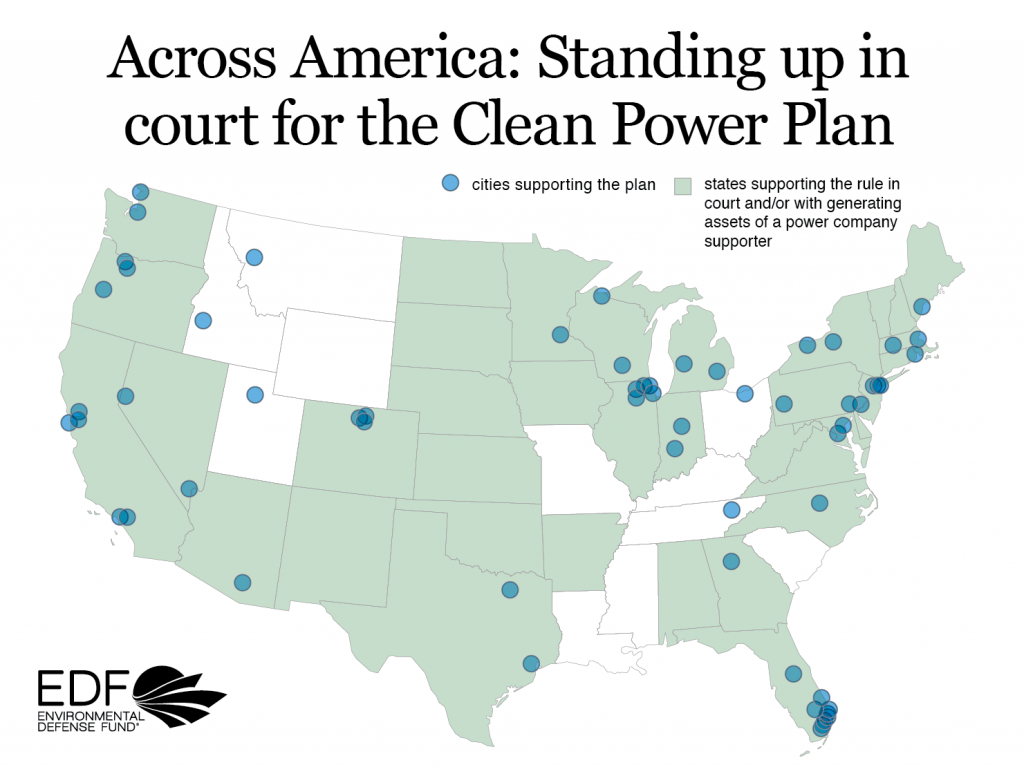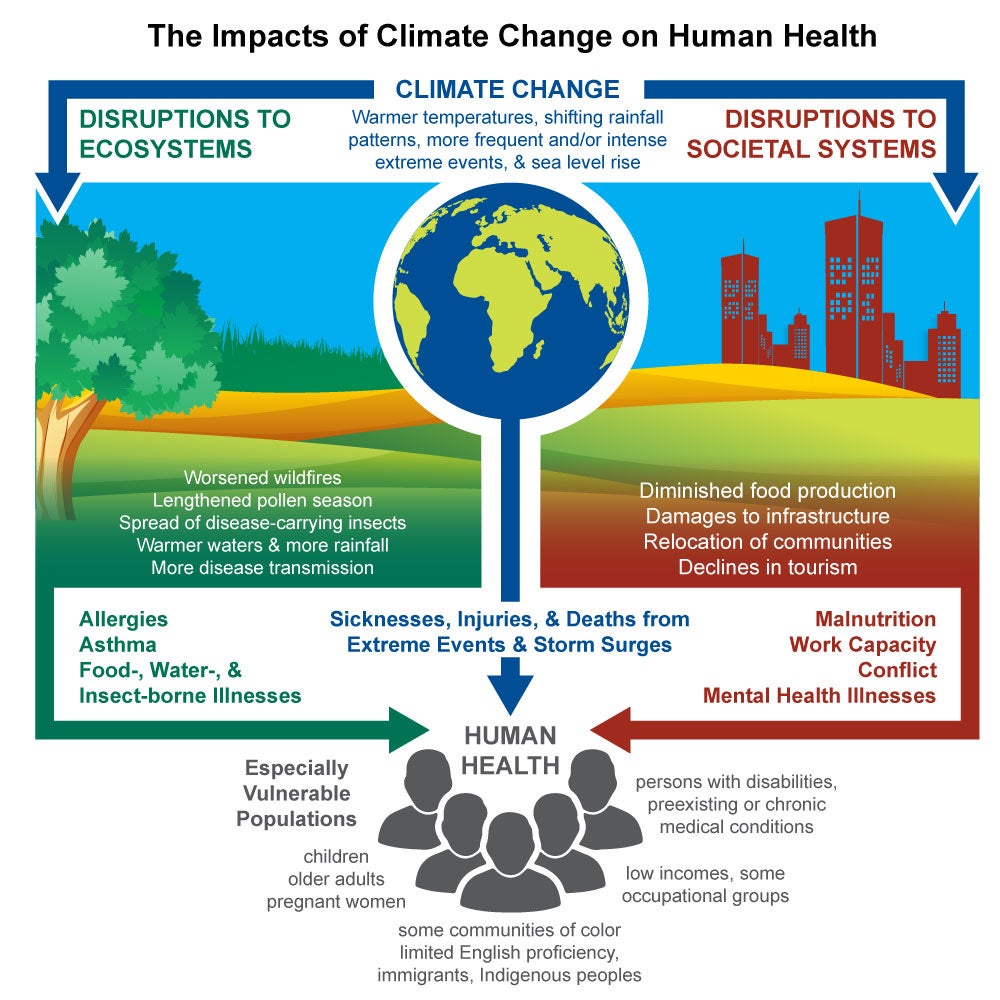 An extraordinarily broad coalition of states, cities, leading companies, members of Congress, medical associations, consumer and ratepayer experts, and organizations from across the country underscored their support for the Clean Power Plan earlier this month, filing a host of legal briefs in court to defend the Plan against attacks by major polluters.
An extraordinarily broad coalition of states, cities, leading companies, members of Congress, medical associations, consumer and ratepayer experts, and organizations from across the country underscored their support for the Clean Power Plan earlier this month, filing a host of legal briefs in court to defend the Plan against attacks by major polluters.
As EDF’s president Fred Krupp noted, the breadth and rigor of these filings are a powerful demonstration of the “unstoppable momentum for climate action in America.” They underscore the huge stakes for our public health and economic well-being as the United States Court of Appeals for the D.C. Circuit considers legal challenges to the first limits on emissions of carbon pollution from existing power plants – the nation’s largest source of climate-destabilizing carbon emissions.
This broad coalition of support was especially compelling due to the tremendous experts with deep experience who filed briefs addressing the legally and technically solid foundation of the Clean Power Plan and its strong anchor in precedent.
In this post, I highlight just a few of these expert briefs, and look at how they reinforce the robust case for the Clean Power Plan.
(EDF has compiled all of the briefs filed in the case – you can read them here)
Former EPA Administrators under Presidents Nixon, Reagan, and George H.W. Bush
Support for the Clean Power Plan’s legal approach was emphasized by two tested experts — former Republican Administrators of the U.S. Environmental Protection Agency (EPA) who have extensive firsthand experience implementing the Clean Air Act.
William Ruckelshaus was appointed by President Nixon to serve as the first EPA Administrator and was subsequently appointed to serve as Administrator by President Reagan. William Reilly was appointed by President George H.W. Bush to serve as the seventh EPA Administrator.
Based on their own tremendous experience, the Administrators forcefully explained that the Clean Power Plan is “the very kind of pollution control program” that they “endorsed during their service at EPA”:
The Plan is a pragmatic, flexible, and cost-effective pollution control program, which properly respects State sovereignty by affording States substantial authority and latitude to decide whether and how best to administer its provisions. The Clean Power Plan also falls well within the bounds of an Administrator’s authority to embrace reasonable interpretations of broadly worded statutory language to address unforeseen problems without the need to resort to congressional amendment of current law. Finally, the Clean Power Plan’s careful consideration of the emissions-reduction potential available on the modern interconnected electricity grids, and specifically the Agency’s endorsement of fuel switching among other pollution control techniques, falls squarely within EPA’s purview as the nation’s pollution regulator. (Administrators’ Brief at page1, emphasis added)
As their brief notes, Administrators Ruckelshaus and Reilly:
[A]re familiar with, and implemented, many of the Clean Air Act provisions centrally relevant to this case [and] responded to similarly consequential regulatory challenges under the Clean Air Act and other federal environmental laws. (Administrators’ Brief at page 3)
Key Authors of the Clean Air Act
This theme — emphasizing the Clean Air Act’s compelling legal basis for the Clean Power Plan — is echoed in a separate amicus brief filed by Leon Billings and Thomas Jorling, two former Congressional staffers who “are widely recognized as ‘architects’” of the Clean Air Act. (Clean Air Act Experts’ Brief at page 3)
As these experts explain:
[The Clean Air] Act was intended to create a comprehensive framework empowering the federal and state governments to regulate emissions of any and all air pollutants that harm human health and the environment … [The Clean Power Plan] furthers the intent underlying the Act’s comprehensive framework and is an appropriate and intended exercise of [EPA’s] authority under the Act. (Clean Air Act Experts’ Brief at pages 3 and 4, emphasis added)
Leading Experts on the Operation of the Electric Grid
The Clean Power Plan is firmly based in the realities of the modern power sector and consistent with current industry trends and practices, according to a separate brief by several nationally-known experts on the operation of the electric grid.
As these experts explain:
The Rule’s design is eminently sensible: it reflects the regional nature of the power system, facilitates familiar compliance approaches such as emissions trading, and gradually accelerates industry trends already underway, as aging coal-fired units are replaced with cheaper, cleaner natural gas and renewable energy generation … [The grid experts] believe that the Rule is consistent with the grids’ twin aims: power reliability and affordability for all consumers. Petitioners’ claims that the Rule will result in grid “restructuring,” “reliability problems,” and other dire consequences are unfounded, and stem from fundamental misunderstandings, or misrepresentations, of how the grids respond to pollution controls. (Grid Experts’ Brief at pages 2 and 3, emphasis added)
Sixteen Former State Energy and Environmental Officials from States Including Texas, Ohio, Oklahoma, Colorado, and Indiana
Sixteen former state officials emphasized that the emission reduction targets in the Clean Power Plan are eminently achievable and consistent with current policies and investment plans at the state level:
As a result of market forces and state efforts to support energy efficiency, renewable energy, and emissions trading programs, many states already have or can easily achieve CPP emission targets.(Former State Officials’ Brief at page 9, emphasis added)
The former state officials’ brief also explains that the Clean Power Plan respects and preserves traditional state authority over energy policy. Among other things, the brief describes how the Clean Power Plan provides each state with extensive flexibility to adopt solutions that are appropriate for local needs and priorities, can readily be implemented through familiar emissions management programs that are in widespread use in the power sector, and have been applied by dozens of states:
The CPP’s flexible approach offers states the opportunity to choose options that best meet their energy, environmental, and economic objectives …The CPP does not change the states’ role in regulating the power sector … By design, the CPP respects and preserves the fundamental roles of grid operators and the jurisdiction of state regulatory bodies, including environmental agencies and Public Utility Commissions (PUC). (Former State Officials’ Brief at pages 2, 3, and 4)
The Experts Agree
This strong support for the Clean Power Plan comes from a remarkable breadth of experts responsible for crafting and implementing our nation’s clean air laws, working to address important public health and environmental challenges within the cooperative federalism framework of the Clean Air Act, and carrying out energy and environmental policy in the states — efforts that have led to dramatic declines in harmful air pollution in recent decades, all while America has maintained robust economic growth as well as reliable, affordable electricity supplies.
These experts agree — the Clean Power Plan is a vital next step in America’s successful efforts to combat air pollution and climate change. The legal and technical foundations of the Clean Power Plan are rock solid.











